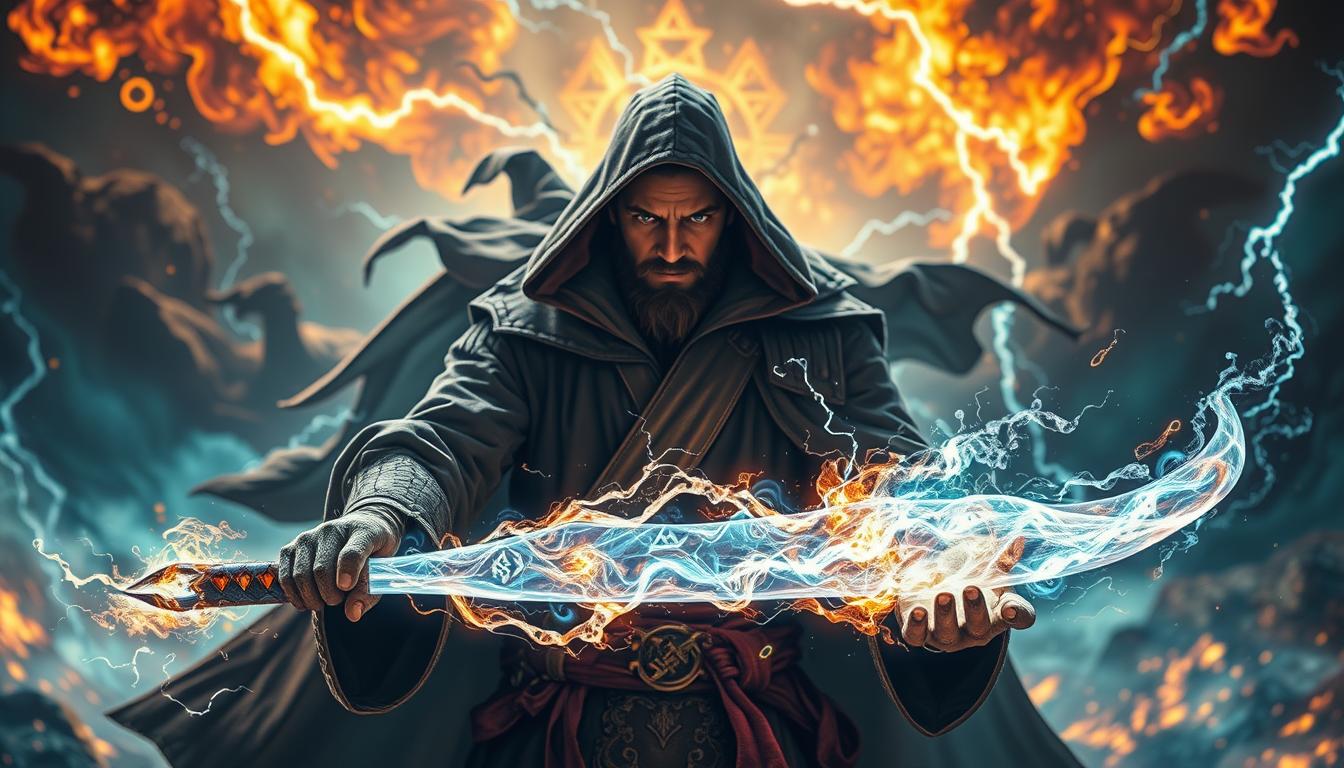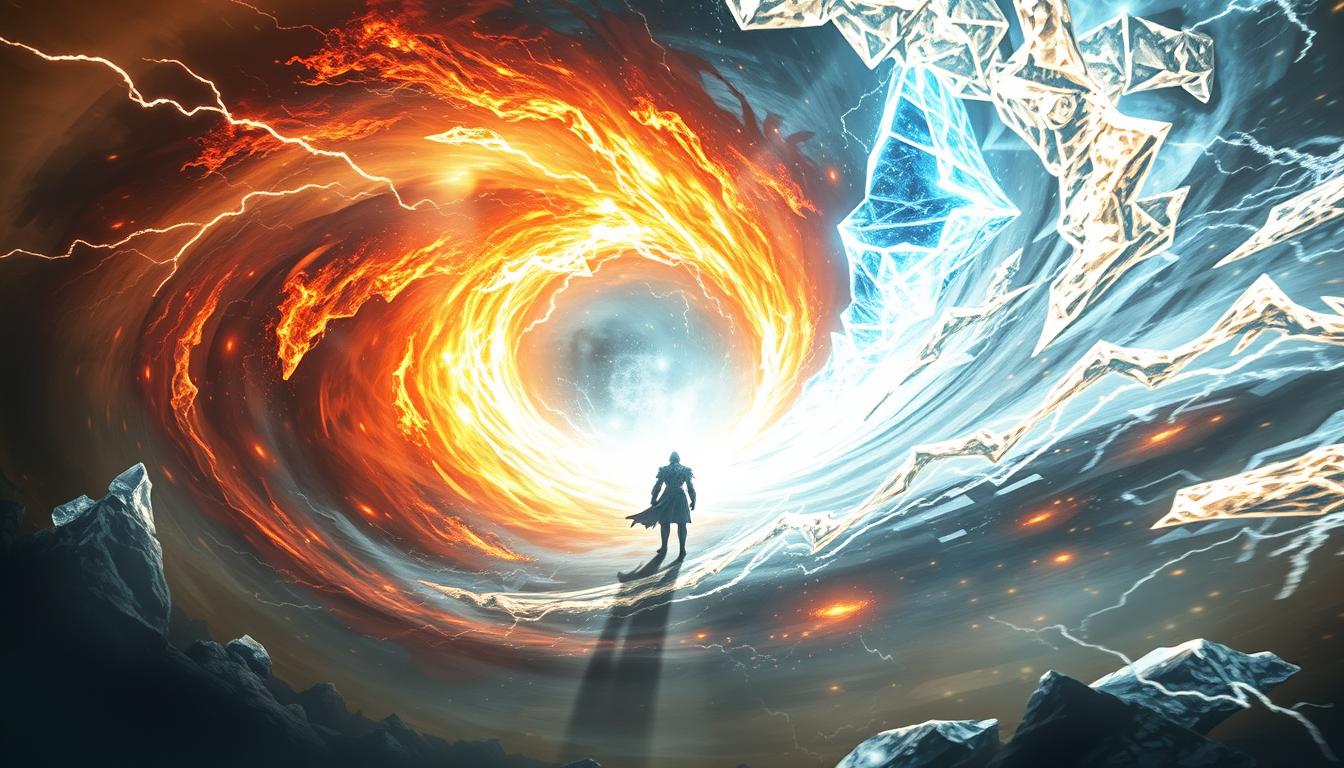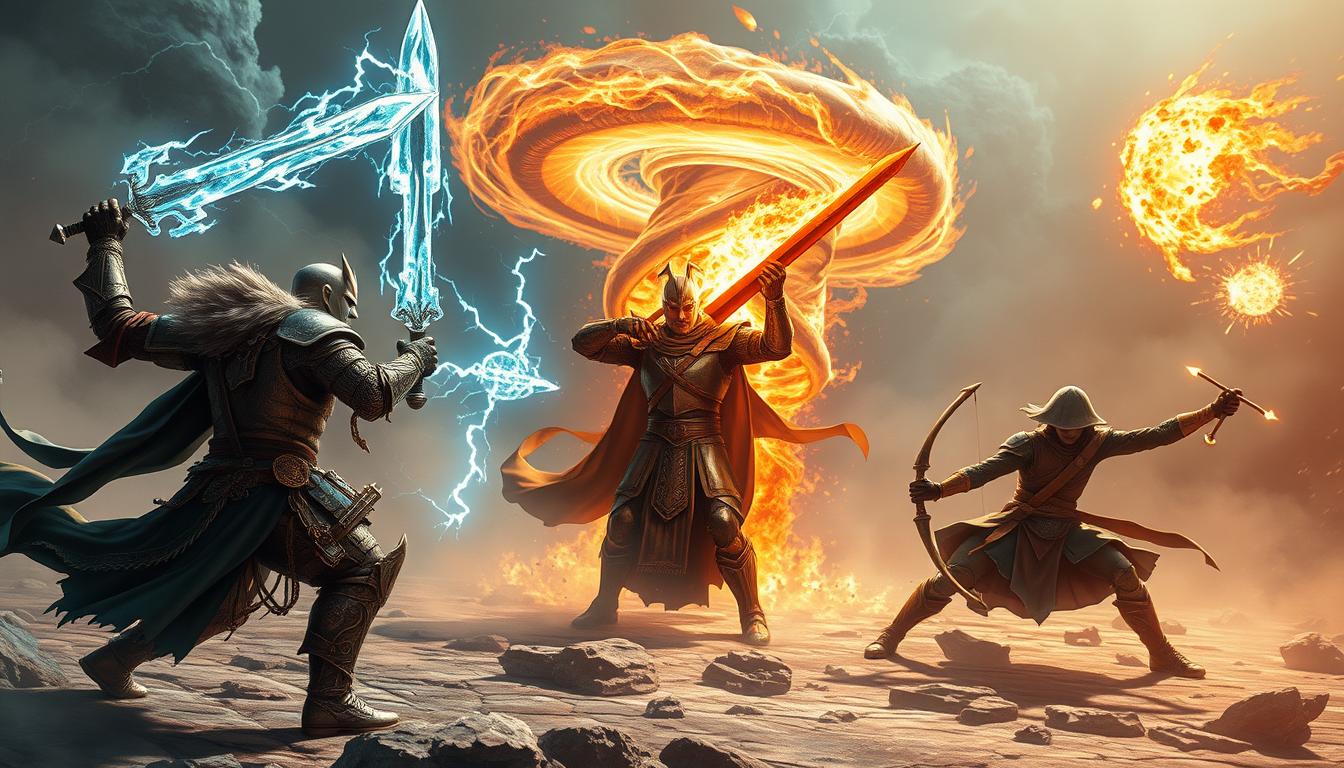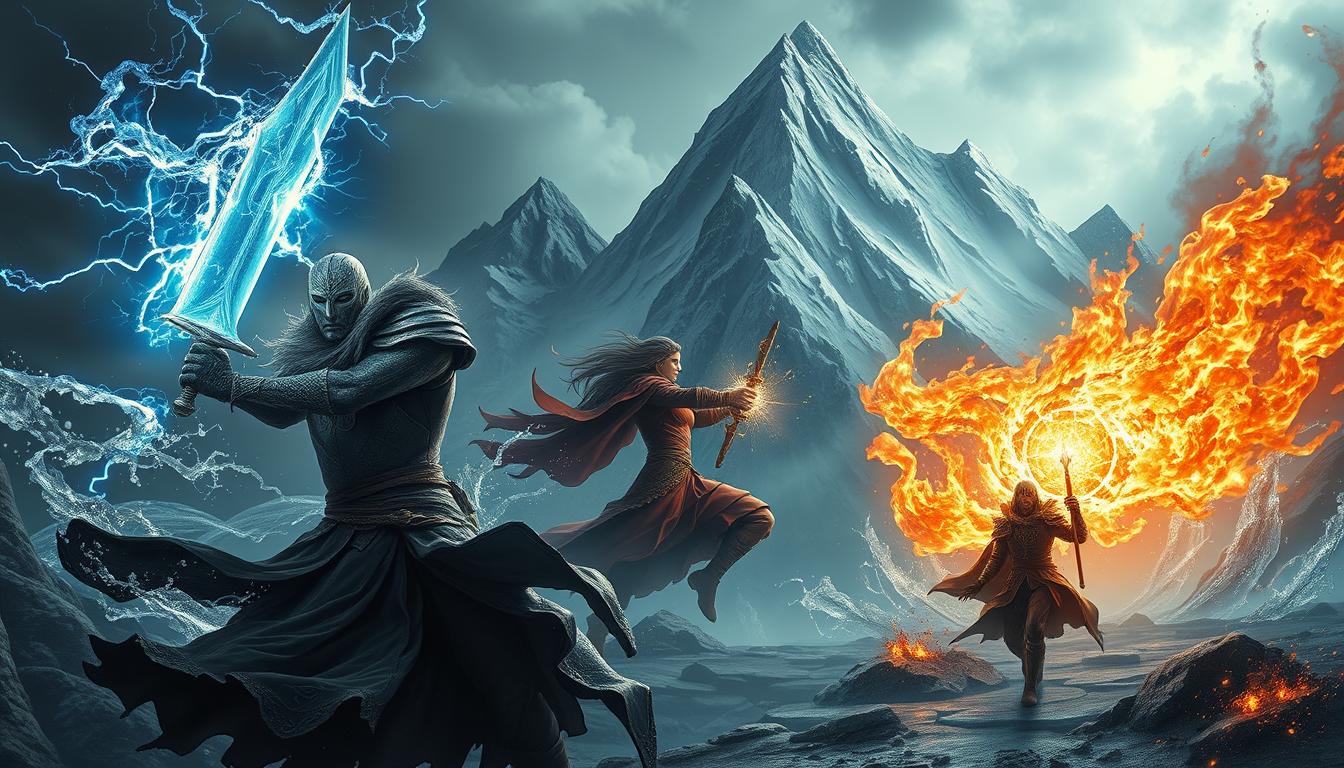Elemental Weapon 5e: Unleash Powerful Abilities
Ever wondered how a simple buff can turn the tide of battle in your favor? In the world of Dungeons & Dragons, few spells pack as much punch as Elemental Weapon. This 3rd-level transmutation doesn’t just give your blade a glow-up—it supercharges it with raw elemental force.

Whether you’re a Paladin smiting foes or a Hexblade Warlock weaving chaos, this spell offers a deadly edge. It grants a +1 bonus to attack rolls and adds 1d4 damage of your chosen element—fire, cold, or lightning. That means exploiting enemy weaknesses while keeping your strikes sharp.
But here’s the kicker: it’s not just about raw power. Smart players use it to outmaneuver opponents, pairing it with clever tactics we’ll explore later. Ready to transform your game?
Key Takeaways
- Boosts attack rolls and adds elemental damage
- Ideal for Paladins and Hexblade Warlocks
- Exploits enemy vulnerabilities effectively
- Scales with higher spell slots
- Versatile for different combat scenarios
What Is Elemental Weapon 5e?
Not all buffs are created equal—some bring raw elemental fury to your strikes. This spell transforms any mundane blade into a force of nature, adding both precision and explosive power.
The Basics of the Spell
As a 3rd-level transmutation, it requires a touch and a level 3 slot. For 1 hour, your weapon gains a +1 bonus to attack rolls and deals an extra 1d4 damage (acid, cold, fire, lightning, or thunder).
Concentration is key here. Lose focus, and the effect fades. But master it, and you’ll exploit weaknesses like fire against trolls or lightning on water-drenched foes.
How It Differs from Other Weapon Buffs
Magic Weapon offers higher attack bonuses (+1 to +3) but lacks elemental flair. This spell trades raw numbers for versatility, letting you adapt to enemy vulnerabilities.
- Stacking: Works with Magic Weapon but not similar effects like Draconic Elemental Weapon.
- Variants: Items like the Drakethroat Glaive mimic its effects with unique twists.
Choose wisely—sometimes a flaming sword is worth more than a +2 bonus.
How Elemental Weapon 5e Works
Timing and element choice make this buff a game-changer. Unlike flat bonuses, it rewards planning and adaptability. Let’s break down the mechanics.
Spell Mechanics and Properties
This spell costs an action to cast, so use it pre-combat. At base level (3rd), it adds +1 to attacks and 1d4 elemental damage. Upcasting boosts both: 5th-level slots give +2 and 2d4, while 7th+ slots hit +3 and 3d4.
Sorcerers can twin-cast it, enhancing two weapons at once. Perfect for dual-wielders.
Damage Types and Their Uses
Pick your element wisely:
- Fire: Common vulnerability (trolls, plants).
- Lightning: Synergizes with wet terrain or Tempest Clerics.
- Cold: Rarely resisted, but fewer foes weak to it.

Range, Duration, and Concentration
Touch range means frontline fighters benefit most. The 1-hour duration covers most fights, but concentration is a risk. Pair with War Caster to avoid drops.
Pro tip: Twinned Spell (Sorcerer) lets you buff two allies—great for flanking setups.
Classes That Can Use Elemental Weapon 5e
Not every adventurer can harness this spell’s power, but those who do become forces of nature. While many classes can access it, a few turn it into a signature move.
Paladins and Their Synergy
Paladins unlock this at 9th level, and it’s a match made in heaven. Their Extra Attack feature doubles the bonus damage, and smites stack with the elemental effect. Imagine a fiery greatsword strike followed by a radiant explosion—ouch.
Hexblade Warlocks: The Upcasting Experts
Hexblades get it earlier (5th level) and exploit high-tier spell slots. At 9th level, their 5d4 lightning damage per hit melts bosses. Few can match their sustained DPS.
Other Classes with Access
Rangers and Druids (2024 rules) use it situationally. Rangers pair it with Volley for multi-target bursts, while Druids in wild shape pass the buff to allies. Bards and Magic Initiate users face magic competition—their concentration is better spent on crowd control.
Pro tip: The Drakethroat Glaive offers a non-caster alternative, mimicking the spell’s effects without slots.
Upcasting Elemental Weapon 5e
Upcasting isn’t just an option—it’s a tactical advantage. By investing higher spell slots, you transform this buff from solid to spectacular. Here’s how to maximize its potential.

Benefits of Higher Spell Slots
A 5th- or 6th-level slot boosts the attack bonus to +2 and adds 2d4 damage. At 7th+ level, it jumps to +3 and 3d4. That’s an average of +7.5 damage per hit—brutal for Fighters with 3+ attacks.
Imagine a level 11 Fighter with three swings: 3d4 x 3 means +21 damage per round. Against bosses with high AC, the extra attack bonus is just as valuable as the raw power.
When to Upcast vs. When to Save Slots
Prioritize upcasting in:
- Boss fights: Melt high-HP targets fast.
- Dangerous encounters: Overcome resistances with the right element.
But conserve slots in dungeons with multiple fights. Warlocks should upcast early—their pact-bound spell slots refresh on short rests. Paladins might save slots for smites instead.
Pro tip: Pair this with Hexblade’s Curse for crit-fishing builds. A 19-20 crit range with 3d4 lightning damage? Yes, please.
Best Strategies for Using Elemental Weapon 5e
Smart players don’t just cast this spell—they weaponize it. The real magic happens when you pair raw power with clever tactics. Here’s how to dominate the battlefield.
Exploiting Enemy Vulnerabilities
Not all damage is equal. Target weaknesses for double the payoff:
- Fire: Melt trolls or scare off icy creatures.
- Lightning: Tempest Clerics can maximize this with Destructive Wrath.
- Cold: Shatter remorhazes or freeze water-bound foes.
Use terrain to your advantage. Wet enemies take extra lightning damage—perfect for coastal ambushes.
Pairing with Multi-Attack Characters
Fighters, Gloom Stalkers, and Hasted allies turn this buff into a bonus machine. More attacks mean more elemental procs.
| Class | Attacks/Round | Potential Damage (3d4) |
| Fighter (Action Surge) | 6+ | 18d4 (45 avg) |
| Gloom Stalker | 3 (1st turn) | 9d4 (22.5 avg) |
Combos with Other Spells and Abilities
Stack effects for explosive turns:
- Crusader’s Mantle: Party-wide +1d4 radiant damage.
- Booming Blade: Add thunder damage on top of your element.
- Delegate concentration to NPCs in safe spots during boss fights.
Pro tip: Rangers with Volley can apply the effect to multiple targets—ideal for swarms.
Elemental Weapon 5e vs. Magic Weapon
Choosing between two powerful buffs can shape your entire combat strategy. Both Magic Weapon and its elemental counterpart enhance attacks, but they excel in different scenarios. Knowing which spell to prepare could save your party from disaster.
Comparing Damage and Utility
Magic Weapon shines early-game. As a 2nd-level spell, it gives +1 to attack rolls—perfect when facing high-AC foes at lower levels. It lacks elemental effects but upgrades nonmagical gear instantly.
The elemental version trades raw bonus power for versatility. That 1d4 damage adds up against vulnerable enemies. Fire against trolls? Lightning in a storm? These situational boosts often outvalue flat +1 bonuses.
- Magic Weapon pros:
- Lower slot cost (2nd-level)
- Better against high-AC enemies
- Elemental pros:
- Bypasses resistances
- Exploits vulnerabilities

Which Spell to Choose and When
Pick Magic Weapon when:
- Your campaign features few elemental weaknesses
- You’re below 5th level and need reliable hits
Switch to the elemental variant for:
- Predictable enemy types (e.g., Against the Giants)
- Parties with multiple damage dealers
House rule idea: Let Magic Weapon add 1d4 elemental damage when upcast to 4th-level or higher. This bridges the gap between both spells' strengths.
Tips for DMs: Balancing Elemental Weapon 5e
Smart DMs know how to turn a player’s strength into a challenge. When your party relies heavily on this spell, it’s time to get creative. Here’s how to keep encounters thrilling without nerfing their fun.
How to Challenge Players Using This Spell
Disrupt their rhythm. Enemies with Absorb Elements or Protection from Energy can nullify bursts of damage. Heat Metal forces concentration checks—perfect for punishing overconfident casters.
Vary enemy types. Fire elementals laugh off flames, while lightning-resistant foes shrug off shocks. Keep players guessing.
Creative Enemy Resistances and Counters
Not all counters need to be obvious. Try these twists:
- Invisible Stalkers: Target backline casters to break weapons buffs.
- Timed Puzzles: Limit the hour-long duration with escalating threats.
- Environmental Hazards: Thunder damage collapses tunnels—reward creative uses.
| Element | Counter Tactics | Reward Creative Play |
| Fire | Fire shields, steam clouds | Melt ice bridges |
| Lightning | Rubber armor, storm giants | Power machinery |
Remember: this spell doesn’t stack with Draconic effects. Clarify rules early to avoid game-breaking combos.
Conclusion
Mastering this buff means turning preparation into domination. It’s a spell for those who plan ahead, turning predictable fights into crushing victories.
Don’t sleep on thunder damage—it’s rare but devastating when timed right. Pair it with a Divination Wizard’s Portent for guaranteed crits that’ll make your DM sweat.
Final verdict? A-tier in campaigns with elemental themes, B-tier elsewhere. But hey, the fun lies in experimentation.
Got a wild story about your flaming greatsword or lightning daggers? Share it below—I’d love to hear how you’ve bent this weapon buff to your will.